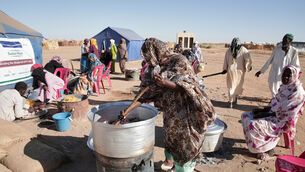3,000 may be trapped in rubble after quake
One of the survivors high-fived her rescuers as they carried her to safety.
The government said nearly 3,000 may still be trapped under the rubble after Wednesday’s 7.6-magnitude quake toppled thousands of buildings on Sumatra island. Some 1,100 are thought to have been killed. Paramedics laid out dozens of corpses, and the stench of decomposing bodies filled the air.
Some victims have yet to receive help. In a district north of the hard-hit city of Padang, stricken residents said they had seen no rescue workers. Most structures there had been levelled, and people were using shovels and their bare hands to clear dig out bodies.
Against a grim backdrop of grief and destruction, rescuers found a reason to cheer: Ratna Kurniasari Virgo, 19, an English student , and a teacher, Susi Revika Wulan Sari, were found alive under the rubble of their college in Padang, the Foreign Language School of Prayoga.
Sari was extricated almost exactly 48 hours after the college crumbled in the quake on Wednesday. She spent the time pinned down by the rubble among dead bodies of her students. Yesterday, she beamed and slapped the hands of the rescue workers as they carried her away.
“She was conscious. Only her legs and fingers are swollen because she was squeezed,” said the institute’s director, Teresia Lianawaty. “Thank God. It is a miracle.”
Earlier, Virgo was yanked out, also conscious, after a 40-hour ordeal of being trapped in the rubble.
With excited shouts and giving words of encouragement to each other, rescuers pulled Virgo hands-first from a hole drilled in the debris. Her olive-coloured T-shirt almost spotless, Virgo was laid on a stretcher before being taken to hospital to be treated for a broken leg.
“She is fine, conscious and does not have any life-threatening injuries,” said Nining Rosanti, a nurse, at the hospital.
Elsewhere in the city, at the site of the former Ambacang Hotel where as many as 100 were feared trapped, rescue workers detected signs of life under a hill of tangled steel, concrete slabs and broken bricks of the three-story structure, said Gagah Prakosa, a spokesman of the rescue team.
“We heard some voices of people under the rubble, but as you can see the damage is making it very difficult to extricate them,” Prakosa said, as a backhoe cleared the debris noisily.
The voices were heard 44 hours after the disaster, giving hope that many lives could still be saved.
But as the first foreign relief teams made their way to the scene, Indonesian officials said a lack of heavy digging equipment was hampering the search.
“Heavy equipment and rescuers are our priority,” said spokesman Priyadi Kardono of the Health Ministry’s national disaster management agency.
Kardono said nearly 3,000 people may still be trapped under rubble. It is the first confirmed government figure for the missing, suggesting that the final death toll could be in the thousands.
The damage from the undersea quake was believed most extensive around Padang, a coastal town of 900,000 people and the capital of heavily populated West Sumatra province.
But about 80 kilometres to the north, in the rural, hilly district of Pariaman, which is home to about 370,000 people, there were virtually no buildings still standing. The region was largely cut off and had received no outside help, leaving many to clear roads of landslides and dig out bodies using shovels and bare hands.
Officials said more than 10,000 homes and buildings had been destroyed there. It was unclear how many had died.














